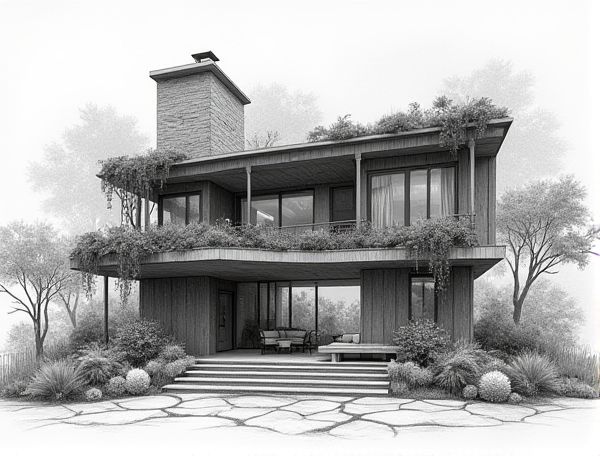
Photo illustration: Urban jungle home design with vertical hydroponic gardens
Transform your living space into a lush urban jungle by integrating vertical hydroponic gardens, which maximize greenery without sacrificing floor space and promote cleaner indoor air. Discover how this innovative design approach can revitalize Your home environment and inspire your next project by reading more in the article.
Introduction to Urban Jungle Home Design
Urban Jungle Home Design integrates lush indoor plants with modern living spaces to create a tranquil, nature-inspired environment. Emphasizing biophilic elements, this style enhances air quality and promotes mental well-being by incorporating diverse greenery such as ferns, succulents, and tropical foliage. Strategic placement of planters, natural wood furnishings, and ample natural light contribute to the authentic urban jungle aesthetic.
Benefits of Vertical Hydroponic Gardens at Home
Vertical hydroponic gardens maximize limited space by allowing homeowners to grow a variety of fresh vegetables and herbs indoors, enhancing air quality and reducing grocery costs. These soil-free systems promote faster plant growth through efficient nutrient delivery, minimize water usage by up to 90%, and enable year-round cultivation regardless of outdoor climate.
Choosing the Right Space for Indoor Gardens
Selecting the ideal space for your indoor garden depends on factors like natural light, temperature, and humidity levels. South-facing windows provide optimal sunlight, while areas near vents or radiators should be avoided to prevent stress on plants. Ensuring the right environment enhances plant growth and seamlessly integrates your garden into your home design.
Essential Components of a Home Hydroponic System
A home hydroponic system relies on key components such as a nutrient reservoir, a growing medium like coco coir or rockwool, and a water pump to circulate the nutrient solution. Precise control of pH and electrical conductivity (EC) levels is essential for optimal plant growth, supported by timers and grow lights that mimic natural sunlight. Efficient aeration through air stones and consistent temperature regulation further enhance root development and overall yield.
Selecting the Best Plants for Vertical Growing
Choosing ideal plants for vertical growing involves selecting species with compact root systems and climbing or trailing habits, such as pothos, philodendron, and ferns, which thrive in limited soil space. Succulents and herbs like thyme or mint also adapt well to vertical gardens due to their minimal water and nutrient requirements. Incorporating a variety of textures and growth patterns enhances both visual appeal and space efficiency in vertical garden designs.
Aesthetic Tips for Lush, Green Interiors
Incorporate a variety of indoor plants like ferns, pothos, and succulents to create a vibrant, green atmosphere that enhances air quality and visual appeal. Choose natural materials such as wooden furniture and stone accents to complement the lush greenery, making your home feel both inviting and organically stylish.
Lighting Solutions for Indoor Hydroponics
Energy-efficient LED grow lights tailored for indoor hydroponics optimize plant growth by providing full-spectrum light that mimics natural sunlight, enhancing photosynthesis and nutrient absorption. Smart lighting systems with adjustable intensity and timing improve crop yield while reducing electricity consumption and heat emission in controlled environments.
Smart Automation and Maintenance Strategies
Smart automation integrates IoT devices and AI-driven systems to optimize energy efficiency and enhance security in modern homes. Predictive maintenance strategies use data analytics to monitor equipment health, prevent breakdowns, and reduce long-term repair costs.
Eco-Friendly Materials for Urban Garden Setups
Using eco-friendly materials such as reclaimed wood, bamboo, and recycled metal enhances the sustainability of urban garden setups by reducing environmental impact and promoting resource efficiency. Incorporating organic soil amendments and biodegradable planters supports healthier plant growth while minimizing plastic waste in compact city spaces.
Inspiring Urban Jungle Home Design Ideas
Transform your living space into a thriving urban jungle by incorporating a variety of indoor plants like fiddle leaf figs, snake plants, and monstera deliciosa that improve air quality and create a calming atmosphere. Utilize vertical gardens and floating shelves to maximize greenery in limited spaces, adding texture and depth while maintaining a modern aesthetic. Combine natural materials such as reclaimed wood and rattan furniture with vibrant green accents to seamlessly blend nature-inspired elements into contemporary urban home designs.
 homedesy.com
homedesy.com